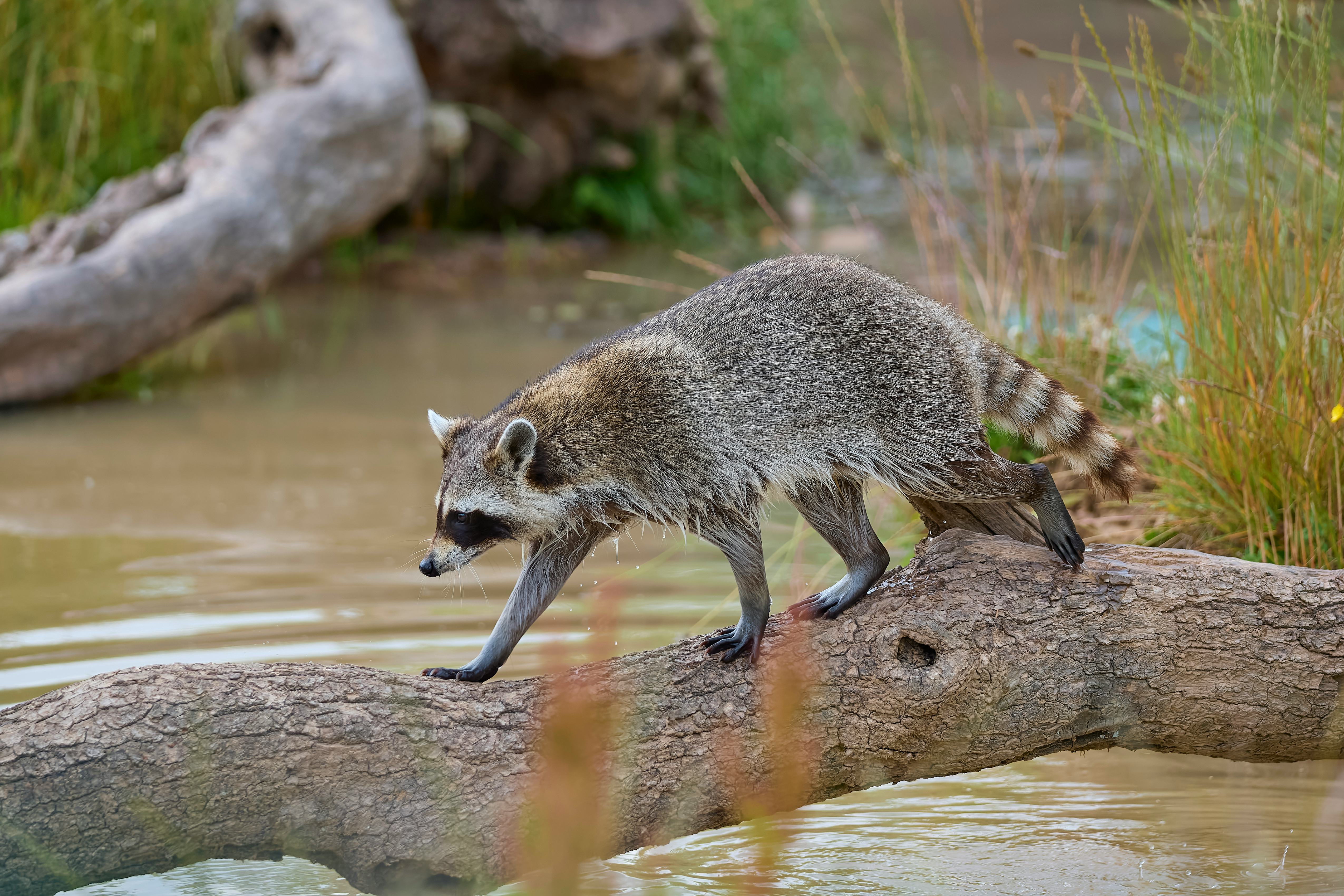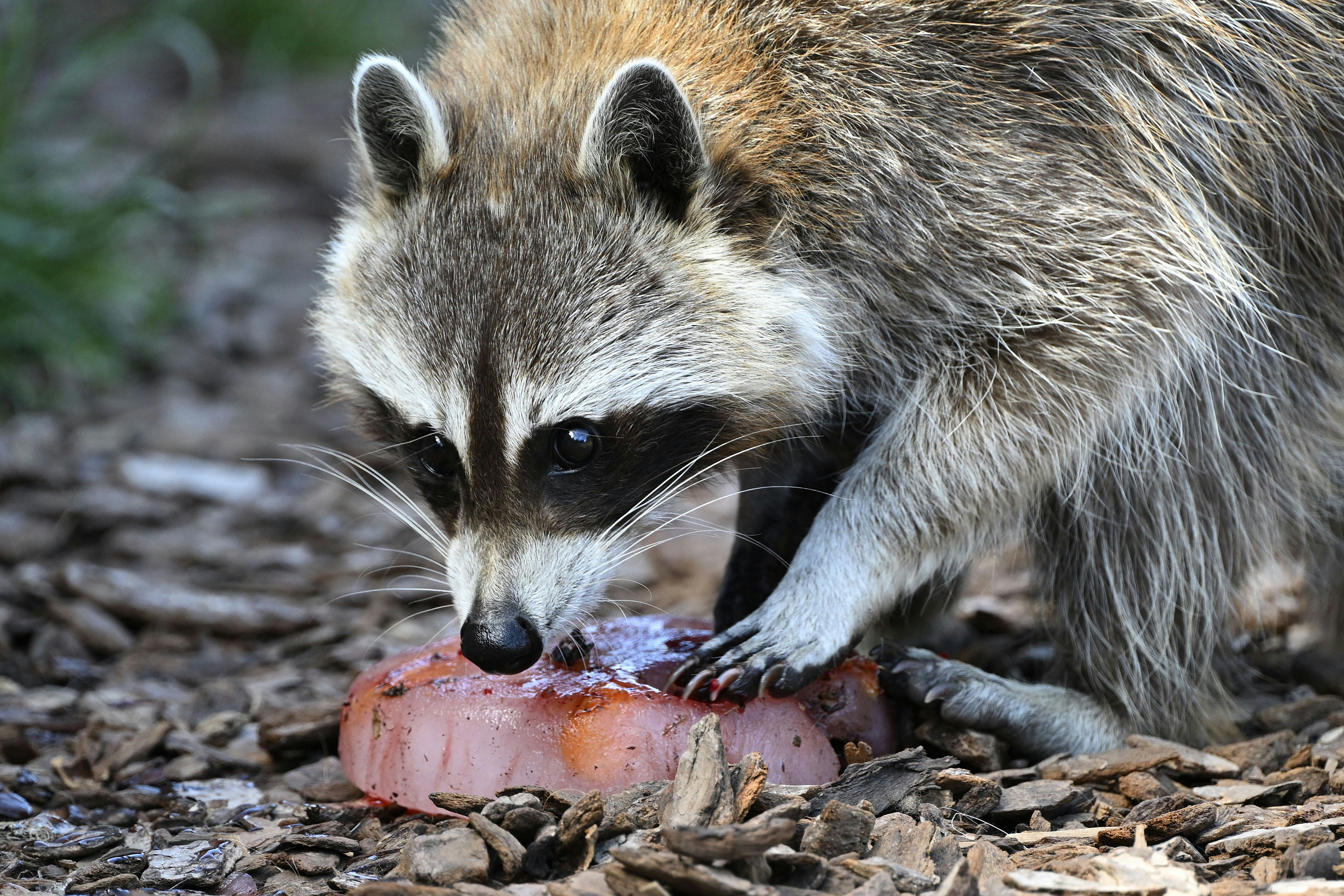
These days, the internet’s favorite animals are trash-foraging critters like rats, possums, and especially raccoons. Raccoons (Procyon lotor) are little bandits that steal our hearts, again and again, starring in memes and breaking social media daily.
As these mammals have been upgraded from pests to garbage can kings, their intelligence is also getting some recognition. Everyone loves how brainy octopuses, pigs, and dogs are, but raccoons also have their own cognitive prowess.
Lauren Stanton, a postdoctoral researcher studying animal cognition at the University of California, Berkeley, understands the raccoon’s appeal.
“They’re fluffy, they have these really adorable faces and round ears, they have a lot of traits that I think make them objectively pretty cute,” she tells Inverse. But she’s most taken with “how tactile they are.” The animals’ dexterous forepaws that help them travel, escape, forage, and hunt inspired Stanton to embrace her inner raccoon.
“Every time I’m feeling the bottom of my backpack looking for a pen, or I’m reaching into a cabinet and trying to find a mug, and I’m feeling my way to finding something, that strikes me as a very raccoon thing to do,” she says.
She also knows that these highly meme-able animals have way more depth than we suspect, which is why she investigates their cognitive abilities. Most recently, she and her team have published a paper in the Journal of Experimental Biology that shows how a raccoon with one trait, in particular, may be associated with these trash pandas’ cognitive abilities.
Their several-year study in Laramie, Wyoming, involved trapping, tagging, releasing, and testing dozens of raccoons, and it shows which type of raccoon showed the most promising cognition. Not only do these findings tell us which raccoons best adapt to and thrive in human-dominated environments like cities, but they may reveal more about other wild animal adaptability.
What’s new — They say it’s always the quiet ones you need to look out for. Stanton’s data shows that just might be true, at least for raccoons.
Between 2015 and 2019, Stanton and her team studied dozens of raccoons for personality traits and later for cognition. The work came in two parts.
Between 2015 and 2019, the team enticed and trapped raccoons using cat food. They brought these raccoons to the lab, where they injected them with a passive integrated transponder (PIT) tag to identify the animals via radio frequency identification (RFID) once they were released. (PIT tags are also used to identify pet cats and dogs.) The researchers fed the raccoons before relinquishing them.
This phase wasn’t just about PIT tagging. The researchers observed each raccoon’s every move and response in this stressful experience. Did the raccoons stick their limbs out of the cage? Did they go quiet in the cage? Did they vocalize, and how so? Did they accept the food and water they were given? All these clues let researchers know what kind of raccoon they were dealing with, and the team classified each one based on traits such as boldness, aggressiveness, docility, and more. Some raccoons had such strong personalities that the researchers named them Volcano or Sriracha for their feistiness.
Then, between 2018 and 2019, came the cognitive testing portion. Stanton’s team devised what’s called a Skinner box, an instrument named for 20th-century American psychologist B.F. Skinner that an animal can manipulate in order to influence a particular outcome. This particular Skinner box had two buttons and contained dog food. There were two ways raccoons could obtain food: first simply by approaching the box, and then by learning how to operate it by pressing the correct button.
After watching 40 raccoons (and four skunks) interact with the box, Stanton observed a correlation between raccoons that expressed docile traits and raccoons who learned to successfully operate the box.
Why it matters — Raccoons and other animals have been forced to adapt to anthropogenic spaces as more land has been developed into cities and suburbs. Understanding how raccoons learn, Stanton says, could indicate a link between cognition and emotional reactivity, which is particularly relevant in volatile environments like cities.
In her research, Stanton learned that animal behavior was viewed on a spectrum of aggressive to docile. Those who were more aggressive were also more likely to be active and bold, exploring their surroundings. The meeker ones were more likely to stay back for a longer period of time before venturing out. The link seems clear in the correlation Stanton’s team found: Raccoons that were observed as docile were more likely to learn how to operate the box.
It could be that more docile raccoons are also more flexible and can more easily adapt to their surroundings. It wasn’t simply that they learned to operate the box, for example. Raccoons received a food reward for simply approaching the box, which introduced the association. Some, however, ran off at the food dispenser’s sound. Not only did the meeker ones learn to use technology, but they simply stuck around with an unfamiliar object.
This flexibility may be integral to surviving in urban environments. Stanton says some theories pose that cities select for what she calls “reactive cognitive phenotypes,” which are the docile creatures who may be less reactive and more tolerant of humans. An aggressive raccoon that bolts at the first sight of a person will never learn that, had they stuck around, they would have been rewarded with hot dogs.

Digging into the details — So just how smart are raccoons? Stanton quotes dog cognition expert Brian Hare: “Asking if one species is more intelligent than another is like asking if a hammer is a better tool than a screwdriver.” They can all learn and adapt in different ways, depending on the tools they have.
Researchers have used Skinner boxes to assess other animals, like birds, in the past, and raccoons are now coming into vogue in fieldwork as on the internet. For this particular study, Stanton recognizes the issue of sample size. She and her team tagged 204 raccoons, but only 40 of them engaged with the box. She did, on the one hand, anticipate that some tagged raccoons would either migrate or perish before they could ever get to the box.
Cognitive testing on mid-size mammals like raccoons gets tricky, she says. But it also sets the groundwork for future research and begs questions of replicability. “Is there an actual relationship between the aggression that’s being demonstrated and their stress levels and their cognitive ability?” she says. “There’s a lot more testing that we’re hopefully going to do to really validate that relationship.”
She also points to how the strongest indicator of aggression or docility was their vocalizations. While their other behaviors couldn’t necessarily be replicated in similar instances, Stanton found that raccoons that were more likely to growl, hiss, and snarl once will likely do it again and that this behavior strongly correlates with aggressiveness.

What’s next — The Laramie raccoons also participated in a study on their learning and problem-solving abilities, a study which will come out soon. In this other experiment, the garbage pups had to learn how to open a door on a puzzle box to obtain food inside. Then, Stanton and her team compared the performance of successful raccoons to find any variations.
As for the four accidental skunks that joined the study, Stanton is elated that the concept applies to other mesocarnivore species, including the “fabulous” skunk, even if she can’t immediately include the data.
But most immediately, these data tell us that raccoons also observe and learn from humans, even if they’re not meme-ing us.
“All to say, our study supports the idea that raccoon behavior can be shaped by human behavior, so as long as we are mindful of our actions, raccoons will figure out what is or is not desired by humans,” Stanton says, “and this can help promote coexistence with them.”







